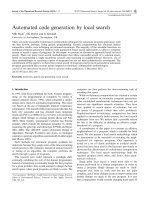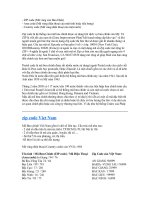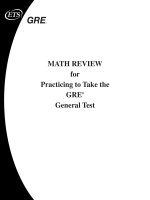Math ebooks code
Bạn đang xem bản rút gọn của tài liệu. Xem và tải ngay bản đầy đủ của tài liệu tại đây (158.65 KB, 22 trang )
Binary Error Correcting Codes
1
Basic concepts of Error correcting Codes
In communication system, we represent an information as a sequence of 0
an 1 (binary form). For a convenience, let B = {0, 1}. Then we define
B 2 , B 3 , . . . , B n as follows :
B 2 = {00, 01, 10, 11},
B 3 = {000, 001, 010, 100, 011, 101, 110, 11},
..
.
B n = {b1 b2 . . . bn |bi ∈ B}
A symbol b1 b2 . . . bn ∈ B n is called a word. We always denote 0 and 1 for
00 . . . 0 and 11 . . . 1, respectively.
We define binary operations +, · : B × B → B as follows :
+ 0 1
· 0 1
0 0 1
0 0 0
1 1 0
1 0 1
Clearly, (B, +) is an abelian group.
Exercise 1.1. Let b1 b2 . . . bn , c1 c2 . . . cn ∈ B n and for each i = 1, 2, . . . , n, let
di = bi + ci as above table. Define a binary operation + : B n × B n → B n by
(b1 b2 . . . bn , c1 c2 . . . cn ) → d1 d2 . . . dn .
1
i) verify that (B n , +) is an abelian group,
ii) for each b1 b2 . . . bn ∈ B n , determine its inverse.
The following diagram provides a rough idea of general information transmitted system.
Noise
e
Message word
✲ Code word
Encoding
w
✲ Recieved word
Transmission
✲ Message word
Decoding
r
E(w)
D(r)
Fig.1 : The communication channel
From above figure, we give concepts of a binary (n, m) code as follows:
Definition 1.1. Let k, n ∈ N be such that m < n. A binary (n, m) code (or
code) compose of :
1. an injective function E : B m → B n , called an encoding function,
2. a function D : B n → B m such that D(E(w)) = w for all w ∈ B m ,
called a decoding function.
We call a set M ⊆ B m a set of massage, w ∈ M a message word, C := E(M )
a code, c ∈ C a code word, r ∈ Dom(D) a received word .
2
In general, M = B m . WLOG, we assume for a convenience that M = B m .
Then a code C := E(M ) = E(B m ) and |C| = 2m .
Definition 1.2. Let C ⊆ B n be a code and c ∈ C. If a word r is received
(from c) and e ∈ B n is such that r = c + e, we call e an error (or error
pattern).
Example 1.1 ( Even parity-check code). We define
E : B m → B m+1 by b1 b2 . . . bm → b1 b2 . . . bm bm+1
where
bm+1 =
0 if the number of 1s in b1 b2 . . . bm is even
1 if the number of 1s in b1 b2 . . . bm is odd
and
D : B m+1 → B m
by
b1 b2 . . . bm bm+1 →
b1 b2 . . . bm
if the number of 1s in b1 b2 . . . bm is even
00 . . . 0
if the number of 1s in b1 b2 . . . bm is odd
Then even parity-check code is an (m + 1, m) code.
For example, B 3 is encoded as follow :
message word
code word
000
001
010 100
0000 0011
011
0110
3
101 110 111
The following received words are decoded as in the table :
received word
1110 0101 0110 0001 1010 1101
message word
000
101
Example 1.2 ( Triple-repetition code). Triple-repetition code is (3m, m)
code such that an encoding function
E : B m → B 3m
is defined by
b1 b2 . . . bm → b1 b2 . . . b m b1 b2 . . . bm b1 b2 . . . b m
and a decoding function
D : B 3m → B m
is defined by
x1 x2 . . . xm y1 y2 . . . ym z1 z2 . . . zm → b1 b2 . . . bm
where
bi →
0 if 0 occurs in xi yi zi at least twice
1
if 1 occurs in xi yi zi at least twice
4
For example, B 3 is encoded as follow :
message
000
001
code word
000 000 000
010
100
011
101
110
010 010 010
The following received words are decoded as in the table :
received word
101 101 101 010 111 110 011 101 110 001 101 001 111 000, 101
message word
101
Moreover, n−repetition code is defined similarly.
Nearest Neighbor Decoding : For a code C, if a word r is received, it is
decoded as the code word in C closest to it.
Complete Nearest Neighbor Decoding : If more than one candidate appears,
choose arbitrarily.
Incomplete Nearest Neighbor Decoding : If more than one candidate appears,
request a retransmission.
To measure a distance between any two code words, we introduce the
Hamming distance as follow :
Definition 1.3. Let u = u1 u2 . . . un , v = v1 v2 . . . vn ∈ B n . The distance
d(u, v) of u and v is defined by
d(u, v) = |{i ∈ {1, 2, . . . , n}|ui = ui }|.
The weight w(u) of u is defined by
w(u) = |{i ∈ {1, 2, . . . , n}|ui = 0}|
5
111
The distance and weight defined above are called the Hamming-distance
and Hamming-weight , respectively.
Lemma 1.1. Let u, v ∈ B n . Then w(u) = d(u, 0) and d(u, v) = w(u + v).
Lemma 1.2. Let u, v, w ∈ B n . Then
i) d(u, v) ≥ 0,
ii) d(u, v) = 0 iff u = v,
iii) d(u, v) = d(v, u),
iv) d(u, v) ≤ d(u, w) + d(w, v),
and hence (B n , d) is a metric space.
Example 1.3. Let C = {0000000, 1001100, 1101101, 0110011} be a (7, 2)
code.
The following table displays Hamming weight of each code word in C :
code word v
Hamming weight w(v)
0000000
1001100
3
1101101
0110011
6
The following table displays H-distance between any two code words in C :
d
0000000 1001100 1101101 0110011
0000000
0
3
1001100
1101101
0110011
5
Assume that complete nearest neighbor decoding is used. We introduce two
methods to decode received words. Let r be a received word.
1. Find the closest code word v ∈ C such that d(r, v) ≤ d(r, u) for all
u ∈ C:
2. Since d(r, b) = w(r + b) for all b ∈ B n , r is decoded to v ∈ C such that
w(r + v) ≤ w(r + u) for all u ∈ C
Assume that 0001001, 1010100, 1001001, 0100101, 1110100, 1111111 are received
words. We decode them as follows :
By 1st method,
d
0000000 1001100 1101101 0110011
0001001
2
1010100
3
2
4
1001001
0100101
1110100
1111111
7
5
decode to
1001100
By 2nd method,
+
0000000 1001100 1101101 0110011
decode to
0001001 0001001 1000101 1100100 0111010
0000000
1010100 1010100 0011000 0111001 1100111
1001100
1001001
0101101 1110011
0100101
1110100
1111111
Example 1.4. Let
C = {0111000, 0010010, 1101101, 1001000, 1100010, 0011101, 0110111, 1000111}
be a (7, 4) code. Assume that 0001001, 1010100, 1001001, 0100101, 1110100, 1111111
are received words. We decode them by 2nd method,
+
0111000 0010010 1101101 1001000 1100010 0011101 0110111 1000111
0001001
1010100
1001001
0100101
1110100
1111111
Definition 1.4. Let C be a code such that |C| = 1. The minimum distance
d(C) of C is
d(C) = min{d(u, v)|u, v ∈ C, u = v}.
8
decode to
The minimum weight w(C) of C is
w(C) = min{w(u)|u ∈ C\{0}}.
The minimum distance of a code tell me about the correction (and detection) capability of its.
Theorem 1.3. Let C ∈ B n be a code. Assume that nearest neighbor decoding
is used. Then
1) If t + 1 ≤ d, then C can detect t−errors.
2) If 2l + 1 ≤ d, then C can correct l−errors.
Example 1.5. Refer to codes in above examples.
1. Even parity check code in Example 1.1 has the minimum distance 2
and hence it can detect at most 1−error but cannot correct any error.
(Verify !)
2. Triple-repetition code in Example 1.2 has the minimum distance 3
and hence it can detect at most
-error(s) and can correct at most
-error(s). (Verify !)
3. A code C in Example 1.3 has the minimum distance
can detect at most
-error(s) and can correct at most
4. A code C in Example 1.4 has the minimum distance
can detect at most
-error(s) and can correct at most
9
and hence it
-error(s).
and hence it
-error(s).
Example 1.6. Let C = {00000000, 11101011, 01011110, 10110101} be a (8, 2)
code. Distance between any two code words display on the table :
d
00000000 11101011 01011110 10110101
00000000
0
6
5
5
11101011
6
0
5
5
01011110
5
5
0
6
10110101
5
5
6
0
Then C has the minimum distance 5. This means that can correct at most
2−errors.
Assume complete nearest neighbor decoding is used. If words 11111111, 00001011
and 11110000 are received, we can decode as follow :
+
00000000 11101011 01011110 10110101
decode to
describtion
11111111
11111111 00010100 10100001 01001010
11101011
can correct 2−errors
00001011
00001011 11100000 01010101 10111110
11110000
11110000 00011011 10101110 01000101
choose arbitrarily cannot correct some 3−errors
10110101
can correct some 3−errors
When size of code is large, the minimum distance of code is hard to compute. Next, we introduce you a more efficiency code which is called a linear
code (or group code).
10
2
Linear Codes (group codes)
Recall that (B n , +) is an abelian group.
Definition 2.1. A (n, k) code C ⊆ B n is called a linear code (or group code)
if for all u, v ∈ C, u + v ∈ C.
Exercise 2.1. Let C ⊆ B n be a code. Verify that “C is a linear code if and
only if C is a subgroup of B n ”.
Since C is a subgroup of B n , by Lagrange’s Theorem |C|||B n | = 2n and
hence |C| = 2k for some k ∈ {0, 1, 2, . . . , n}. This means that C contain 2k
words of length n.
Definition 2.2. We call a linear code C ⊆ B n with |C| = 2k an [n, k] code .
If an [n, k] code C has the minimum distance C, we call C an [n, k, d] code.
Example 2.1. Refer to codes in above examples.
1. Even parity check code in Example 1.1 is a linear code with the minimum distance 2. Hence it is a [m + 1, m, 1] code. (Verify !)
2. Triple-repetition code in Example 1.2 is a linear code with the minimum
distance 3. Hence it is a [3m, m, 3] code. (Verify !)
3. A code C in Example 1.6 is a [8, 2, 5] code.(Verify !)
Theorem 2.1. Let C ⊆ B n be a linear code. Then d(C) = w(C).
Example 2.2. Consider the code
C = {000000, 001110, 010101, 011011, 100011, 101101, 110110, 111000}. Then
C is a linear code (verify!) and hence C has the minimum distance
d(C) = w(C) = 3, i.e., C is a [6, 3, 3] code.
11
Example 2.3. Consider the code C = {111111, 100110, 010001, 011010}.
Then C has the minimum distance d(C) = 3 is not equal to w(C) = 2. Why?
For any code, we can decode by methods which described in Example 1.3.
Now, If C is a linear code, we have more efficiency methods.
2.1
Cosets and Coset Decoding
Since an [n, k] code C is a subgroup of B n , for u ∈ B n , u + C = {u + v|v ∈ C}
is called a coset of C generated by u. Clearly, the number of all (distinct)
2n
n
coset of C is [B : C] = k = 2n−k .
2
Definition 2.3. For a coset u + C, we call v ∈ u + C a coset leader if
w(v) ≤ w(u + C).
Note that a coset leader may not unique.
Example 2.4. Consider a code C = {0000, 0110, 1011, 1101}. Then C is
a linear [4, 2, 2] code. Then we obtain cosets and coset leaders (underline
words) :
C + 0000 C + 0100 C + 1000 C + 0001
0000
0100
1000
0001
0110
0010
1110
0111
1011
1111
0011
1010
1101
1001
0101
1100
The above table is called the standard decoding array (or standard array).
Coset Decoding:
Let C be an [n, k] code. If a word r ∈ B n is received
and v is the coset leader for r + C, then decode r as r + v.
12
Theorem 2.2. Coset decoding is nearest neighbor decoding.
Proof. Let C be an [n, k] code , u ∈ B n and v be a coset leader for u + C.
Since v ∈ u + C, u + C = v + C and hence v := u + v ∈ C. Let x ∈ C. Then
u + x ∈ u + C = v + C, i.e., w(v) ≤ w(u + x). Thus
d(v, u) = w(u + v) = w(v) ≤ w(u + x) = d(u, v).
Example 2.5. Consider the standard array
C + 0000 C + 0100 C + 1000 C + 0001
0000
0100
1000
0001
0110
0010
1110
0111
1011
1111
0011
1010
1101
1001
0101
1100
.
Assume that coset decoding is used. If words 0101, 1010, 1111, 1011, 0111 are
received, then we decode them as r + v where r is a received word and v is a
coset leader :
received word (r)
decode to (r + e)
0101
0101 + 1000 = 1101
1010
.
1111
1011
0111
13
Example 2.6. Construct the standard array for the linear [6, 3, 3] code
C = {000000, 001110, 010101, 011011, 100011, 101101, 110110, 111000}.
C + 000000 C+
C+
C+
C+
C+
C+
C+
000000
001110
010101
.
011011
100011
101101
110110
111000
Assume that coset decoding is used. Decode followings received words :
received word (r)
decode to
(r + v)
010101
101011
111111
.
101100
011110
000111
111110
Describe about correction capability ?
14
2.2
Generator Matrix, Parity-check Matrix and Decoding
For a convenience, we consider a word w = w1 w2 . . . wk ∈ B k as a matrix
w = [ w1 w2 · · · wk ]. Let G be a binary k × n matrix such that k < n.
Then wG = [ w1 w2 · · · wk ] ∈ B n for all w ∈ B k .
Definition 2.4. Let G be a binary k × n matrix such that k < n and the
first k columns is an identity matrix Ik . Define E : B k → B n by E(w) = wG.
Then C := {wG|w ∈ B k } is called a code generated by G and G is called the
(standard) generator matrix for C.
From the above definition, we write G = [Ik A] for some (k × (n − k)
matrix A. Then for each message word u ∈ B k , uG = [uIk uA] = [u uA]
which is easy to retrieve.
Exercise 2.2. Verify the followings :
i) E is an encoding function (i.e., E is injective).
ii) C is a linear code.
Definition 2.5. A binary (n − k) × n matrix H with k < n is called the
(standard) parity-check matrix for a linear [n, k] code C if the last n − k
columns is an identity matrix In−k and Hv t = [0] for all v ∈ C.
Lemma 2.3. If G and H are generator matrix and parity-check matrix for
a linear code C,respectively, then HGt = [0]
15
Theorem 2.4. If G = [Ik A] is a generator matrix for a linear [n, k] code
C, then H = [At In−k ] is a parity check matrix for C.
Conversely, if H = [B In−k ] is a parity check for a linear [n, k] code C, then
G = [Ik B t ] is a generator matrix for C.
Example 2.7. Even parity check code in Example 1.1 is a linear code with
the generator matrix
G = Im
1
..
. .
1
Determine the parity-check matrix for even parity check code?
Triple-repetition code in Example 1.2 is a linear code with the generator matrix
G=
Im Im Im
.
Determine the parity-check matrix for triple-repetition code code?
Example 2.8. Let
1 0 0 0 1 1
G = 0 1 0 1 0 1 .
0 0 1 1 1 0
Then
1. The linear code
C : = {wG|w ∈ B 3 }
={
}.
16
2. The parity-check matrix
H=
3. All cosets and coset leaders
C + 000000 C+
C+
C+
.
17
C+
C+
C+
C+
Example 2.9. Let
1 0
0 1
G=
0 0
0 0
0 0 1 1 1
0 0 1 1 0
.
1 0 1 0 1
0 1 0 1 1
Then
1. The linear code
C : = {wG|w ∈ B 4 }
={
}.
2. The parity-check matrix
H=
18
3. All cosets and coset leaders
C + 000000 C+
C+
C+
C+
C+
C+
.
Definition 2.6. Let H be the parity-check matrix for a linear [n, k] code C.
For each v ∈ B n , the syndrome S(v) of v is defined by S(v) = Hv t
Theorem 2.5. Let H be the parity-check matrix for a linear [n, k] code C
and u, v ∈ B n .Then
19
C+
i) S(u + v) = S(u) + S(v),
ii) S(v) = [0] if and only if v ∈ C,
iii) S(u) = S(v) if and only if u and v are in the same coset.
Definition 2.7. A table which matches each coset leader e with its syndrome
is called a syndrome look-up table.
Syndrome Decoding Let H be the parity-check matrix for a linear [n, k]
code C. If r ∈ B n is received, compute S(r) and find v (in a syndrome
look-up table) such that S(r) = S(v). Decode r as r + v.
Example 2.10. Construct a syndrome look-up table for a [6, 3] code in Example 2.8.
coset leader v
syndrome S(v)
20
Assume that syndrome decoding is used. Decode following received words :
received word (r)
S(r)
decode to
(r + v) s.t. S(r) = S(v)
010101
101011
111111
.
101100
011110
000111
111110
Exercise 2.3. Construct a syndrome look-up table for a [7, 4] code in Example 2.9. Assume that syndrome decoding is used. Then decode following
received words :
0001001, 1010100, 1001001, 0100101, 1110100, 1111111.
Parity-heck Matrix Decoding Let H be the parity-check matrix for a
linear [n, k] code C. If r ∈ B n is received, compute S(r) = Hrt .
1. If S(r) = [0], then r ∈ C and hence decode r as r.
2. If S(r) = [0] and S(r) is column i of H, decode by changing its ith bit.
3. If S(r) = [0] and S(r) is not a column of H, request a retransmission.
Exercise 2.4. For a [7, 4] code in Example 2.9. Assume that parity-check
matrix decoding is used. Then decode followings received words :
0001001, 1010100, 1001001, 0100101, 1110100, 1111111
.
21
References
[1] F.J. MacWilliams and N.J.A. Sloan, The Theory of Error-Correcting
Codes. New York:Elsevier/North Halland, 1977.
[2] San Ling and Chaoping Xing, Coding Theory : A First Course. Cambridge University Press, 2004.
[3] Vera Pless, Introduction to the Theory of Error-Correcting Codes., John
Wiley and Son, 1990.
[4] J.H. Van Lint, Graduate Texts in Matematics : Introduction to Coding
Theory. Spriger-Verlag,1982.
[5] D.G. Hoffman et al, Algebraic Coding Theory.Winnipeg/Canada, 1987.
[6] W.K.Nicholson, Introduction to Abstract Algebra Algebra.John Wiley
& Sons, 1999.
22









